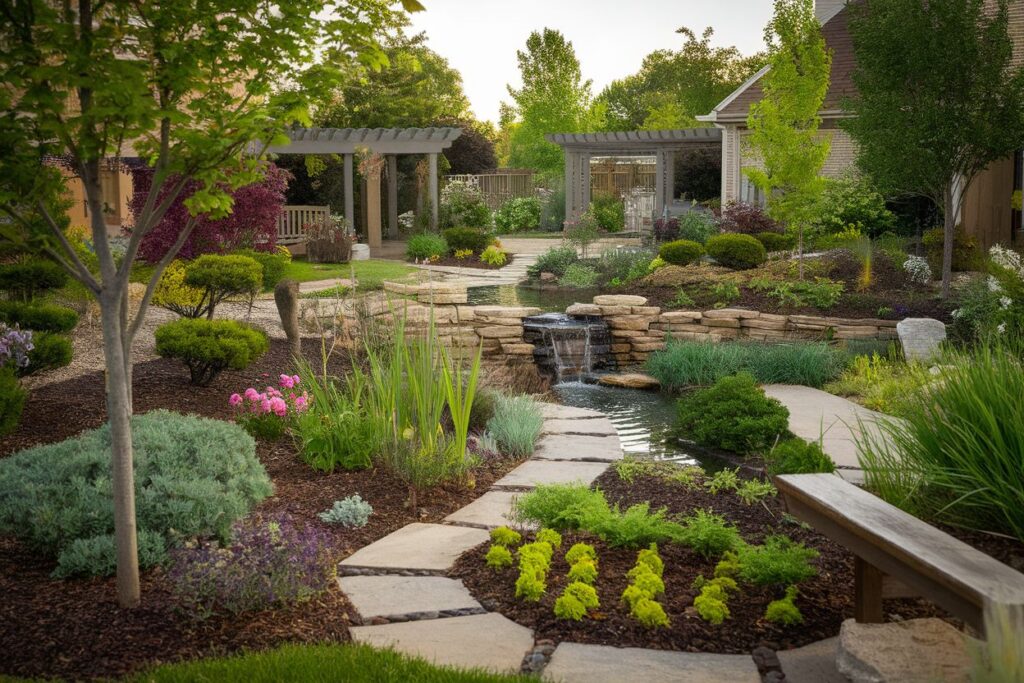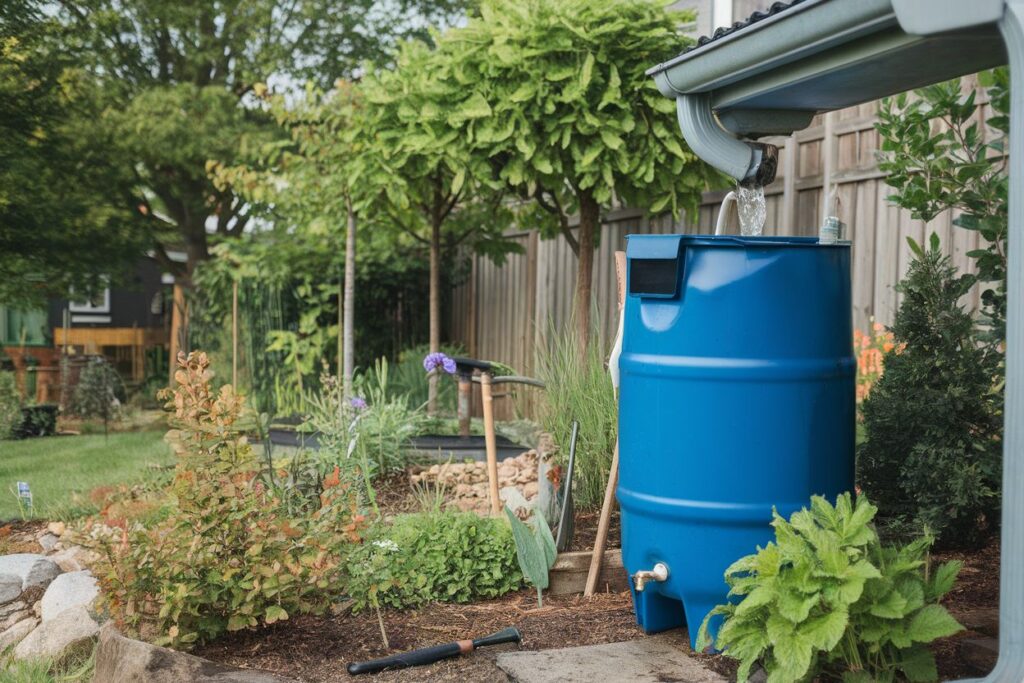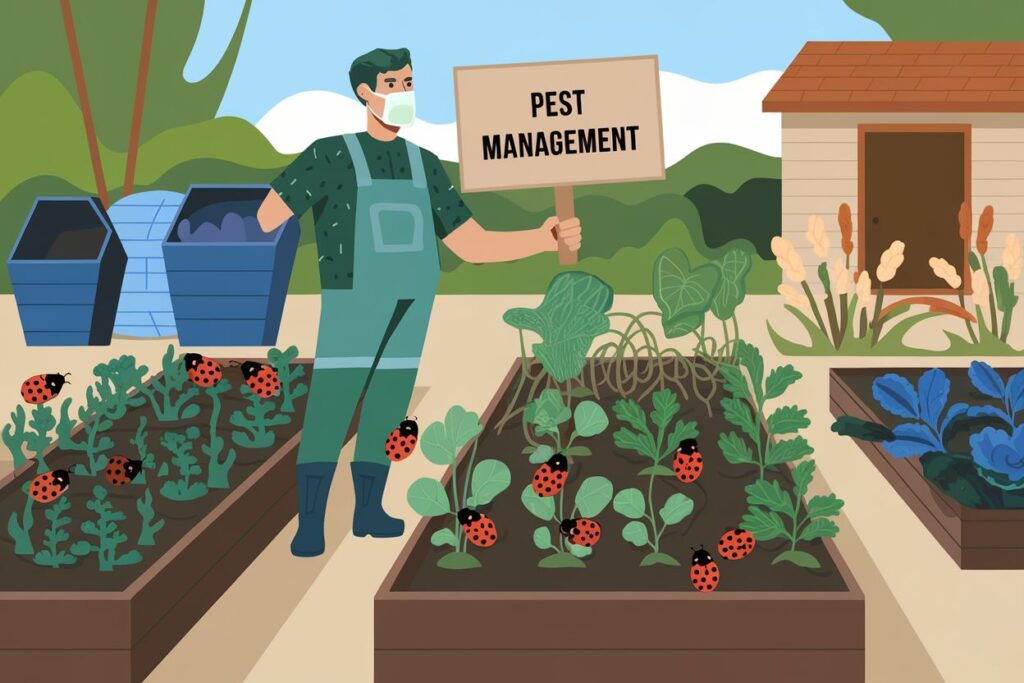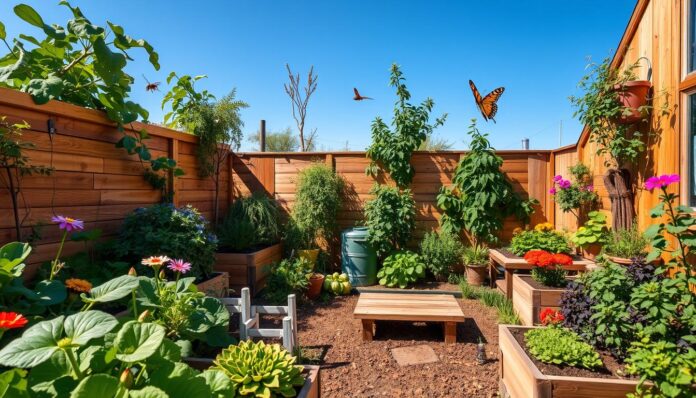Creating a self sustainable garden is rewarding and good for the environment. It lets you grow your own food and live more eco-friendly. A key part of this is using permaculture, which helps plants grow without needing much outside help.
This article will show you how to turn a vegetable garden into a self sustaining system. It encourages you to adopt eco-friendly gardening and increase biodiversity in your garden.
Understanding Self Sustainable Gardening
Self sustainable gardening is about making a garden that grows well with little help from outside. It follows sustainable gardening principles to lessen harm to the environment. It also aims to increase biodiversity and use resources wisely. This way, gardening fits into the natural world.
The core of self sustainable gardening is to grow plants with a small environmental impact. It uses permaculture and organic gardening to make the garden strong. This leads to a variety of plants and animals, keeping the ecosystem healthy and productive.
Benefits of a Self Sustainable Garden
Creating a self sustainable garden brings many benefits. It’s not just about how it looks. It also improves your life and helps the environment.
A self sustainable garden helps the planet. It cuts down on carbon emissions and keeps soil healthy. This boosts biodiversity and supports local wildlife.
It also fights pollution and makes cities greener. This is good for our planet.
Gardening sustainably can save you money. Growing your own food means less spending on groceries. It’s a way to be self-sufficient.
It’s also good for your health and wallet. Practices like composting help you save money. This way, you can grow your own food without breaking the bank.
Planning Your Garden Layout

Effective garden planning is key to a successful garden. Choosing the right spot and using good design techniques are crucial. These steps help your garden grow well and help the environment. Let’s look at important things to think about when planning your garden.
Finding the perfect spot for your garden is vital. Plants do best in places with 6-8 hours of sunlight a day. Also, think about the wind and how easy it is to get to your garden. A spot that’s protected from strong winds helps plants grow stronger.
Using smart design can make your garden more efficient and productive. Raised beds help with drainage and soil quality. Vertical gardening uses space up to grow plants in tight spots. Planting plants that help each other creates a balanced garden ecosystem.
Organizing plants well helps them grow better and increases your harvest. This makes your garden a success.
Soil Health and Management
Keeping soil healthy is key for a self-sustainable garden. Nutrient-rich soil is essential for plant growth and garden health. Practices like composting and soil testing help manage soil sustainably.
Nutrient-rich soil is the base of a thriving garden. It supports strong plant growth and root development. It also keeps moisture in. Nutrients like nitrogen, phosphorus, and potassium are crucial.
Using organic matter like compost boosts soil health. This supports sustainable gardening practices.
Composting turns kitchen scraps and yard waste into organic matter. This enriches soil health. There are different composting methods, like cold and hot composting.
Knowing about carbon-to-nitrogen ratios helps improve composting. This ensures the compost is effective for soil.
Soil testing is vital for checking pH levels and nutrient availability. It helps gardeners make informed decisions on amendments. Testing kits give valuable data for maintaining healthy soil.
Water Conservation Methods

Keeping a garden healthy is key, especially in dry areas. Using smart watering methods helps plants get enough water without wasting it. Here are some ways to do it right.
Using rain barrels to collect water is good for your garden and the planet. A simple setup can catch rainwater from your roof. This water helps your plants when it’s dry, saving water and keeping your garden green.
Drip irrigation changes how we water plants. It sends water straight to the roots, cutting down on evaporation and runoff. This method makes sure plants get the right amount of water, helping them grow strong and healthy.
Mulch keeps the soil moist and helps plants grow better. It stops weeds and keeps the soil cool. Different types of mulch, like straw and wood chips, are good for your garden and show the value of saving water.
Choosing Plants for Your Garden
Choosing the right plants is key to a self-sustainable garden. Factors like native species, companion planting, and seasonal rotation are important. These help create a healthy ecosystem that needs little care.
Native plants are great for your garden. They fit well with the local climate and soil, needing less water and care. They also support local wildlife, like pollinators, which are vital for many plants.
Companion planting pairs plants for mutual benefit. It boosts biodiversity and improves plant health. For instance, marigolds can keep aphids away from vegetables. Knowing these plant relationships can make your garden more productive.
Crop rotation keeps the soil healthy. It prevents soil depletion and pest problems. By rotating crops, you ensure your garden stays productive over time.
Pest Management in a Self Sustainable Garden

Effective pest management is key in a self sustainable garden. Natural methods help avoid harmful chemicals. This approach supports a healthy ecosystem and boosts plant health.
Natural pest control keeps pests away without harming the environment. Use beneficial insects and products like neem oil. These methods help maintain a balanced garden ecosystem.
Attracting beneficial insects is crucial for a self sustainable garden. Pollinators and pest predators like bees and ladybugs help control pests. They also promote plant growth. Creating habitats for these insects ensures their presence in your garden.
Maintenance Practices for Long-term Sustainability
Effective sustainable gardening maintenance is key to a self-sustaining garden. Regular care boosts plant health and keeps the garden thriving for years. It lets gardeners adjust to changes, ensuring long-term success.
Checking the garden regularly is vital. It helps spot diseases, nutrient gaps, and pests. Daily tasks include checking plant health, adjusting water, and using organic fertilizers. This keeps the garden strong and fruitful over time.
Knowing how to adjust gardening with the seasons is crucial. Seasonal gardening means flexible planting and winter prep. By matching gardening to seasonal needs, plants grow better all year.
Final Thoughts
Creating a self sustainable garden lets you enjoy your hard work and helps the environment. It’s not just about growing food. It also saves money, improves soil, and helps local ecosystems.
By using compost, choosing native plants, and saving water, you make your garden strong. It can face climate change’s challenges well.
Every step towards a self sustainable garden is a step towards a better future. You feed yourself and your family. You also help solve big environmental problems.
By gardening sustainably, you support biodiversity and balance in nature. This is good for your community.
It’s time to start your sustainable gardening journey. Begin with a small container garden or a bigger plot. Every effort you make matters.
You can make a big difference. Create a self sustainable garden that shows the power of individual action. It’s a step towards a greener world.











